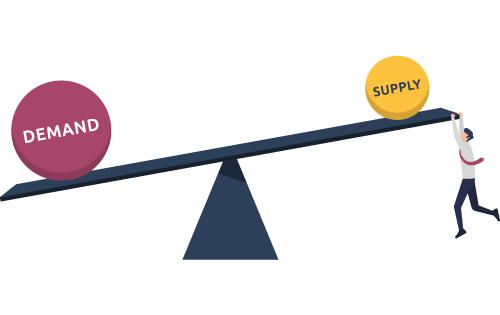How Do You Calculate Average Inventory?
Built For


- The definition of average inventory
- The significance of average inventory
- The average inventory calculation
How Do You Calculate Average Inventory?

Welcome to today’s Q&A blog, and join me as we discuss average inventory.
First off, let’s talk about what inventory actually is. In the simplest terms, inventory is the stuff your business sells – whether it’s car parts, plants, or delicious pastries. It’s the lifeblood of any company that sells physical goods, and managing it well is crucial to keeping your business healthy and your customers happy.
But why focus on the average inventory, you ask? Well, it’s all about balance. Too much inventory can tie up your precious cash and lead to waste, while too little can leave you scrambling to meet demand. That’s where average inventory comes in. It’s a nifty little metric that helps you find that sweet spot, ensuring you have just the right amount of stock on hand to keep things running smoothly.
In this article, we will unwrap the mysteries of average inventory. We’ll explain what it is, why it matters, and, most importantly, how you can calculate it for your business. Whether you’re a seasoned inventory pro or just starting to get your feet wet, we’ve got something for you.
Understanding Average Inventory
If you’ve ever found yourself scratching your head, wondering how many units of this or that you should keep on your shelves or in your warehouse, you’re not alone. It’s the classic business conundrum: predicting the perfect amount of product to have on hand. That’s where understanding average inventory becomes your secret weapon.
What is Average Inventory?
Think of average inventory as the Goldilocks zone of your stock levels – the “just right” amount that’s neither too much nor too little. It represents the average amount of inventory you’ve had available over a certain period. This could be a month, a quarter, or even a year, depending on your business cycle.
The Significance of Average Inventory
Now, you might wonder, “Why average?” Because in the world of business, demand, supply, and sales fluctuate. Looking at the average, you get a smoothed-out picture that’s less likely to be thrown off by temporary spikes or drops. It’s like the difference between weather and climate; one is what you see when you look out the window, and the other is what you expect based on the time of year.
Average inventory is more than just a piece of trivia; it’s a cornerstone of your business’s performance, influencing everything from your financial statements to your purchasing decisions and even affecting your business’s valuation. That’s right—it’s not just about knowing how many widgets to keep in the back room—it’s about financial health, operational efficiency, and strategic planning.
Impact on Business Analysis
Money tied up in inventory is money that’s not doing anything else for your business. If you have too much inventory, your cash flow might start gasping for air. Too little inventory, and you could be missing out on sales. Average inventory helps you maintain that delicate balance, ensuring you’ve enough to meet demand but not so much that your cash is getting dusty on a shelf.
In the next section, we’ll break down the formula for calculating average inventory so you can apply this powerful tool in your business.
The Formula for Calculating Average Inventory
What’s the formula for calculating average inventory? Let’s get our math hats on – it’s simpler than you might think!
The Basic Average Inventory Formula

Here is the average inventory equation:
Average Inventory = (Beginning Inventory + Ending Inventory) / 2
That’s it. That’s the formula. Two parts, one division, and voila! You’ve got your average inventory. But what do these parts mean? Let’s break it down.
Unpacking the Average Inventory Components
- Beginning Inventory: This is the inventory value you have at the start of your accounting period. Think of it as the inventory ‘kick-off’ value before you start your business plays for the period.
- Ending Inventory: This is the inventory left unsold at the end of your accounting period. It’s like the players left on the field when the whistle blows.
So, you’re finding the average of these two numbers. But why average them? Because it gives you a smoother view of your inventory over time, ironing out the wrinkles of seasonal spikes or sales dips.
A Sample Average Inventory Calculation in Action
Let’s say your business started April with $20,000 worth of inventory and ended with $15,000. Your average inventory for April would be:
Average Inventory = ($20,000 + $15,000) / 2 = $35,000 / 2 = $17,500
There you have it. For April, your warehouse shelves held an average of $17,500 worth of inventory. And that’s the formula for average inventory in a nutshell. It’s a handy little helper in your inventory management toolbox. Whether selling directly to consumers, supplying in bulk, or creating products from scratch, knowing your average inventory helps keep your operations smooth and customer satisfaction high.
Factors Affecting Average Inventory Levels
Regarding average inventory, it’s not all about numbers and calculations. There’s a human element and a slew of factors that can cause your average inventory levels to vary from the average. Let’s chat about some factors that play a crucial role in determining your average inventory levels.

Seasonal Trends: Riding the Wave
Have you ever noticed how some items fly off the shelves during certain times of the year? That’s seasonality for you. For instance, an online retailer might stock up on swimwear in the summer but switch gears to cozy sweaters when the leaves start falling. Seasonal trends can cause significant fluctuations in inventory levels, requiring businesses to adapt their ordering and sales strategies throughout the year.
Market Demands: Staying on Your Toes
The market can be as fickle as the weather. A sudden surge in a trend can mean a rush on certain products. If your online store sells the latest gadget that’s gone viral on social media, you must adjust your average inventory levels to meet the clamoring demand. Similarly, a wholesale distributor must be in tune with the market to supply their retailers adequately without overstocking.
Economic Fluctuations: Surfing the Economic Tide
Economic ups and downs can affect consumer purchasing power, impacting inventory levels. In a thriving economy, people might be more inclined to splurge, whereas, in a downturn, they might tighten those purse strings. Keeping an eye on economic indicators helps to anticipate changes in average inventory needs.
Technological Advances: The Digital Transformation
Innovations in inventory management software provide more precise forecasting, leading to more accurate average inventory levels and providing insights into how much stock to keep on hand.
Internal Factors: The Nuts and Bolts
Finally, let’s remember the internal factors like storage capacity, cash flow, and company policies that can affect how much inventory you decide to keep. Whether it’s an online retailer, a wholesale distributor, or a manufacturing business, these internal considerations are pivotal in determining the optimal average inventory levels.
In the grand scheme of things, managing average inventory is a delicate balancing act influenced by a myriad of factors. It’s about staying agile, informed, and ready to pivot when necessary. Keep these factors in mind, and you’ll be better equipped to maintain healthy inventory levels that can handle the ebb and flow of business.
How to Manage and Improve Average Inventory
You have the average inventory formula down, and you understand the factors that can sometimes make your average inventory levels unpredictable. But how do you manage and improve these numbers? Don’t sweat it! Here are some strategies to keep your average inventory just right – not too high, not too low, but just right.

Forecasting
Forecasting is like weather predictions for your stock. Use historical sales data, market trends, and seasonal patterns to predict future sales to help determine how much inventory you should keep on hand.
Inventory Audits
Regular inventory audits are crucial. Whether you do it annually, quarterly, or through continuous cycle counting with an inventory management system, keeping an eye on what you have helps ensure your records match your actual stock. For a wholesale distributor, this might involve regularly spot-checking categories of products.
Supplier Relationships
Nurture good relationships with your suppliers; they’re the backbone of your inventory. If you’re on good terms, they’re more likely to work with you on pricing and delivery schedules, and they might even give you a heads-up on upcoming trends or delays.
Technology, The Smart Approach
Inventory management software automates much of the heavy lifting when tracking stock levels, reordering products, and analyzing sales patterns.
Lean Inventory
Lean inventory methods focus on reducing waste without sacrificing productivity. Identify areas where you can cut costs without impacting customer satisfaction. For manufacturers, this might involve streamlining production processes to minimize the need for excess inventory.
Knowledge is Power
Train your entire business on inventory management best practices. Everyone from the warehouse staff to the sales team should understand how their actions impact inventory levels. The better they understand the process, the smoother your operations will run.
Calculating average inventory is vital for efficient inventory management. It helps you understand what you have and need and how to keep costs down while meeting customer demand. Remember, it’s all about having the right amount of stock at the right time. We’ve discussed understanding average inventory, the formula for calculating it, its applications in different business contexts, and the factors affecting inventory levels.
How Do You Calculate Average Inventory? FAQs
What is average inventory?
Average inventory is the mean amount of inventory a business has over a specific period, usually calculated to understand inventory levels better and manage them efficiently.
Why is calculating average inventory important?
Calculating average inventory helps businesses avoid overstocking or understocking, which can impact customer satisfaction and financial health.
How do you calculate average inventory?
The basic formula for calculating average inventory is: (Beginning Inventory + Ending inventory) / 2.
Can seasonal businesses benefit from calculating average inventory?
Seasonal businesses can adjust their ordering and sales strategies by understanding their average inventory, which can vary significantly throughout the year.
What are some common mistakes to avoid when calculating average inventory?
Some common mistakes include overlooking stock variations, neglecting lead times, disregarding sales patterns, failing to adjust for seasonality, and ignoring inventory accuracy.
Call us at 817-870-1311





